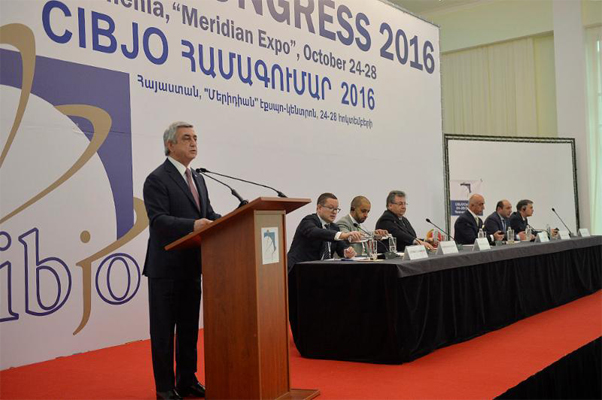 Armenian President Serzh Sargsyan delivers the opening address to the 2016 CIBJO Congress. He is joined on the podium by (from left): Andrey Zharkov, President Alrosa; Ahmed Bin-Sulayem, Chair of the Kimberley Process; Dr. Gaetano Cavalieri, President of CIBJO; Gagik Gevorkyan, outgoing President of the Armenian Jewellers Association, the host of the CIBJO Congress; Suren Karayan, Minister of Economic Development and Investment of the Republic of Armenia; and Andrey Yurin, head of Russia's state precious minerals repository, the Gokhran
Armenian President Serzh Sargsyan delivers the opening address to the 2016 CIBJO Congress. He is joined on the podium by (from left): Andrey Zharkov, President Alrosa; Ahmed Bin-Sulayem, Chair of the Kimberley Process; Dr. Gaetano Cavalieri, President of CIBJO; Gagik Gevorkyan, outgoing President of the Armenian Jewellers Association, the host of the CIBJO Congress; Suren Karayan, Minister of Economic Development and Investment of the Republic of Armenia; and Andrey Yurin, head of Russia's state precious minerals repository, the Gokhran
CIBJO, the World Jewellery Confederation, wrapped up its 2016 congress in Yerevan, Armenia, on Friday, October 28, after five intensive days of discussions on a wide-ranging set of issues facing the gemstone and jewellery industry, and sessions of its specialized commissions covering the diamond, coloured stone, pearl, coral, precious metals and gemmological laboratory sectors, as well as ethics, marketing and education.
The CIBJO Congress, which was the first held by the confederation in the fast-growing Central Asian market, included the three days of formal congress sessions, as well as two pre-congress days of sector and commission steering committee meetings. Held in the newly built convention facility of the Meridian Expo Centre in Yerevan, it was attended by about 120 delegates from all over the world, among them sizable delegation from CIS states, including Armenia, the Russian Federation, Kazakhstan and Kyrgyzstan. The event was hosted by the Armenian Jewellers Association (AJA).
Serving as the venue for the meeting of the CIBJO Assembly of Delegates, the annual congresses are the official forum for confederation members, which currently total 87 national jewellery and gemstone associations from 43 countries, and representatives of 55 of the industry's most important commercial bodies.
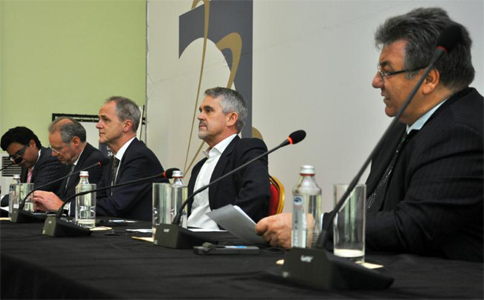 CIBJO President Gaetano Cavalieri (right) leading a panel discussion on issues related to Corporate Social Responsibility at the 2016 CIBJO Congress. He is joined by (from left): Eduardo Escobedo, Executive Director of the Responsible Ecosystems Sourcing Platform (RESP); Stephane Fischler, President of the Antwerp World Diamond Centre (AWDC); Andrew Bone, Executive Director of the Responsible Jewellery Council (RJC), and Ian Harebottle, President and CEO of Gemfields.
CIBJO President Gaetano Cavalieri (right) leading a panel discussion on issues related to Corporate Social Responsibility at the 2016 CIBJO Congress. He is joined by (from left): Eduardo Escobedo, Executive Director of the Responsible Ecosystems Sourcing Platform (RESP); Stephane Fischler, President of the Antwerp World Diamond Centre (AWDC); Andrew Bone, Executive Director of the Responsible Jewellery Council (RJC), and Ian Harebottle, President and CEO of Gemfields.
The 2016 CIBJO Congress was officially opened on October 26, in the presence of the President of the Republic of Armenia, Serzh Sargsyan, who stressed the connection of the Armenian nation to the jewellery business and craft. "Throughout the centuries, Armenian jewellers around the world have had a great input into the development of the global jewellery industry," he stated. "Today, our republic considers jewellery making and diamond polishing to be among its priority industries. It is for that reason that we do our best to assist and promote these industries however we can."
During the Opening Session, President Sargsyan awarded CIBJO President Gaetano Cavalieri with a special medal of gratitude in honour of his and CIBJO's contribution to the jewellery industry in Armenia and worldwide. Dr. Cavalieri accepted the award, emphasising that he was doing so on behalf of CIBJO, its members, and the work done by the confederation on behalf of jewellery and gemstone sector participants, consumers and stakeholders.
In his opening address, Dr. Cavalieri stressed the independence of CIBJO, and its commitment to serve the interests of all players in the greater gemstone and jewellery industries, regardless of size. "CIBJO is the only organisation operating in the industry that considers its area of interest and responsibility to include the entire chain of distribution, from the mine to the consumer outlet, in every country and region where jewellery and gemstones are produced, manufactured and sold," he said. "There are no size restrictions in terms of the individuals or organisations we serve, meaning that our commitment to the wellbeing of the smaller player is as solid and absolute, as is our commitment to the larger players in the business."
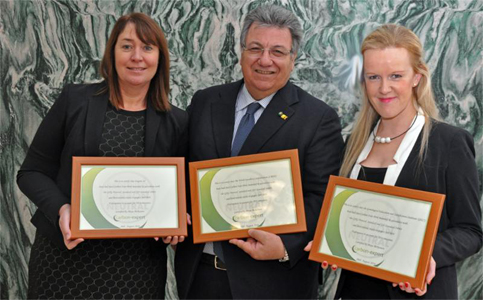 Moya McKeown (left) of Carbon-Expert, together with CIBJO President Gaetano Cavalieri (centre) and Francesca Manfredi, General Manager of GECI, duringthe 2016 CIBJO Congress. They are holding certificates attesting to having retired carbon credits as part of the CIBJO's Greenhouse Gas Measurement Initiative for the jewellery industry. CIBJO retired carbon credits for 2015, and GECI, together with Osigem Srl of Milan, retired carbon credits for 2014.
Moya McKeown (left) of Carbon-Expert, together with CIBJO President Gaetano Cavalieri (centre) and Francesca Manfredi, General Manager of GECI, duringthe 2016 CIBJO Congress. They are holding certificates attesting to having retired carbon credits as part of the CIBJO's Greenhouse Gas Measurement Initiative for the jewellery industry. CIBJO retired carbon credits for 2015, and GECI, together with Osigem Srl of Milan, retired carbon credits for 2014.
"We firmly believe that if you tender and nurture the grass roots of the industry, the business will be inherently healthier. The only entry card into our industry should be a firm commitment to do business fairly and responsibly, always looking out for the interests of your employees, your stakeholders and your customers," Dr. Cavalieri stated.
The congress' first day focussed strongly on the issues of Corporate Social Responsibility and sustainability, with large number of key industry and civil society leaders and experts among the speakers and panel discussion members. They included Ahmed Bin-Sulayem, Chair of the Kimberley Process (KP) and Executive Chairman of the Dubai Multi Commodities Centre; Andrey Yurin, head of Russia's state precious minerals repository, the Gokhran; Andrey Zharkov, President of the world's largest Russian diamond mining giant Alrosa; Ian Harebottle, President and CEO of the world's largest coloured gemstone producer, Gemfields; Andrei Polyakov, President of the World Diamond Council; Andrew Bone, Executive Director of the Responsible Jewellery Council (RJC); Stephane Fischler, President of the Antwerp World Diamond Centre (AWDC); Eduardo Escobedo, Executive Director of the Responsible Ecosystems Sourcing Platform (RESP); and Moya McKeown, a carbon foot-printing expert, who has been working with CIBJO as part of its Jewellery Industry Greenhouse Gas Measuring and Offsetting Initiative.
During the congress, Ms. McKeown awarded a certificates attesting to CIBJO's having retired carbon credits to offset its greenhouse gas footprint for all of 2015, and well as to two other companies that are part of CIBJO initiative - GECI and Osigem Srl of Milan - which retired carbon credits for 2014.
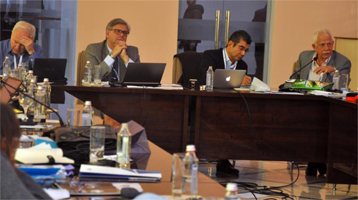 The Coloured Stone Commission in session at the 2016 CIBJO Congress. At the head of the table are seated (from left) Charles Abouchar, Vice President of the Coloured Stone Commission; Thomas Lind, Vice President of CIBJO's Sector A; Nilam Alawdeen, President of the Coloured Stone Commission; and Roland Naftule, President of Sector A. Sector A is the group of commissions within CIBJO dealing with gem materials.
The Coloured Stone Commission in session at the 2016 CIBJO Congress. At the head of the table are seated (from left) Charles Abouchar, Vice President of the Coloured Stone Commission; Thomas Lind, Vice President of CIBJO's Sector A; Nilam Alawdeen, President of the Coloured Stone Commission; and Roland Naftule, President of Sector A. Sector A is the group of commissions within CIBJO dealing with gem materials.
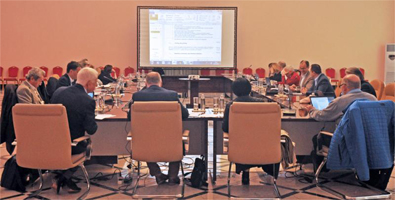 CIBJO's Gemmological Commission Steering Committee in session, two days before the official start of the 2016 CIBJO Congress in Yerevan, Armenia.
CIBJO's Gemmological Commission Steering Committee in session, two days before the official start of the 2016 CIBJO Congress in Yerevan, Armenia.
Other key events at the 2016 CIBJO Congress included:
- A special session organised by the Gemmological Commission that looked at the problem of inconsistencies in coloured gemstone laboratory reports produced by different organisations. It focussed specifically on the colour descriptions "Pigeon's Blood" for ruby and "Royal Blue" for sapphire, which when awarded often raise the price of relevant gemstones.
- An update in the Pearl Commission on the status of CIBJO's yet-to-be released Guide for Classifying Natural and Cultured Pearls.
- A discussion in the Coral Commission of the first set of amendments to the Coral Blue Book, which is the most recent addition to CIBJO's set of industry standards and nomenclature, having been ratified for the first time in 2015.
- A decision in the Diamond Commission to add definitions to the section of the Diamond Blue Book that defines diamond treatments and simulants, including descriptions of imitations, annealing, artificial products which are not crystallised and artificially crystallised stones.
- A discussion in the Coloured Stone Commission about moving towards uniform treatment disclosure for coloured gemstones. Here it was decided to formulate a proposal for such disclosure, and that likely will be tabled at the CIBJO Congress in 2017. There also was a discussion about creating an opal guide, which would cover all types of the gemstone from all regions of the world.
- A discussion in the Precious Metals Commission on changes to regulations governing acceptable levels of nickel in jewellery, so as to prevent adverse reactions caused by jewellery when it comes in direct and prolonged contact with the skin.
- Reports in the Ethics Commission on the online Corporate Social Responsibility (CSR) course, developed by CIBJO together with Branded Trust of Australia, which is accessible through the CIBJO website, and on the Jewellery Industry Summit, which took place in New York City in March as an open forum for discussing sustainability in the jewellery business.
The 2016 CIBJO Congress celebrated the 90th anniversary of CIBJO's founding in 1926, confirming its status as the longest established representative body serving the international industry.
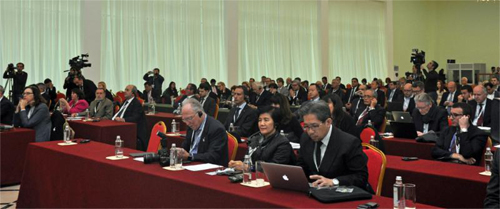 Participants in the 2016 CIBJO Congress in Yerevan, Armenia.
Participants in the 2016 CIBJO Congress in Yerevan, Armenia.